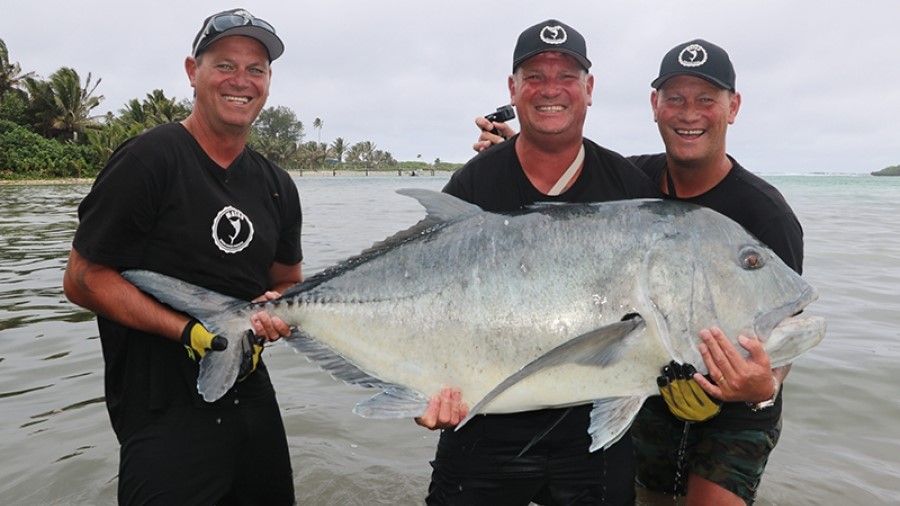Eel behind recent ciguatera cases
Tuesday 25 January 2022 | Written by Al Williams | Published in Health, National

The Cleave brothers Darren (left), Jeff and Martin, with a 60kg Giant Trevally caught near the shore at Avana harbour. 19102111.
There have been two recent cases of ciguatera in Rarotonga – both diagnosed after people consumed eel.
Information supplied by Te Marae Ora Ministry of Health shows 35 cases reported between January and December 2021, and one hospital admission.
Earlier this month two further cases were diagnosed after they consumed eel. Neither were admitted to hospital, Te Marae Ora confirmed.
Of the 35 cases reported in 2021, the majority were from the consumption of lagoon/reef fish – trevally (seven) and snapper Kiriva (six).
Trevally made up the majority of all reported cases (11) followed by snapper Kiriva (seven) and other species (five).
According to marine biologist Dr Teina Rongo, ciguatera is a type of sea food poisoning that can cause intoxication in people when consuming reef fishes.
Ciguatera was first recorded in the early 1980s from Atiu and Mitiaro, and later in the early 1990s, became a problem in Aitutaki and Rarotonga.
Other islands where fish poisoning have occurred include Palmerston and Penrhyn.
“It is still unknown why the other islands in the Cook Islands have not experienced ciguatera,” Rongo said.
In the past two decades, most of the cases have come from Rarotonga and Aitutaki, he said.
The highest incidences were recorded in 2006, which was around 350 people per year, following the five cyclones that passed through the region.
There is no seasonal patterns to ciguatera.
“In fact, the impact of cyclones on reefs have been suggested as a possible cause for driving these cases to increase, according to my research,” Rongo said.
“Cyclones would damage the reef, therefore creating space for algae to grow.
“The organisms that cause ciguatera are microscopic algae that live on the surface of the larger algae that we see on reefs.”
However, there were different types of microscopic algae on the reefs and they were not all toxic, he said.
“In fact the toxic ones are low in numbers because they are poor competitors for space and resources, however, they are opportunistic.
“When the reef is damaged, we can say that their competitors are cleared from the reefs, giving the toxic ones the opportunity to establish.
“They then are inadvertently eaten by reef fishes, herbivores, unicorn fish parrot fish, etc that feed on algae.”
That was how the toxin entered the food web, Romgo said.
“Herbivores are then eaten by carnivores, trevally, barracuda, etc.
“The year 2005 was when the last cyclones passed through Rarotonga, and cases have declined since then; this is something that my research has predicted. It’s good to know that my prediction still holds true.
“Today, cases have fluctuated around (average of) 20 per year, but this is for both Rarotonga and Aitutaki combined.”
Over the years, Rongo said the fear of ciguatera caused a decline in fishing activities, “which is in a way good because it allowed the reefs to recover and stay relatively healthy”.
However, he said as ciguatera incidences continue to remain low, people are now fishing more.
“The concern here is overfishing. This was another contributing factor to ciguatera in the beginning. A healthy population of herbivores can keep algae cover – that host the toxic microscopic algae – low.”




































